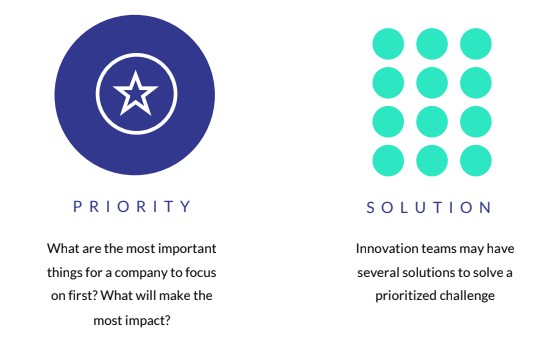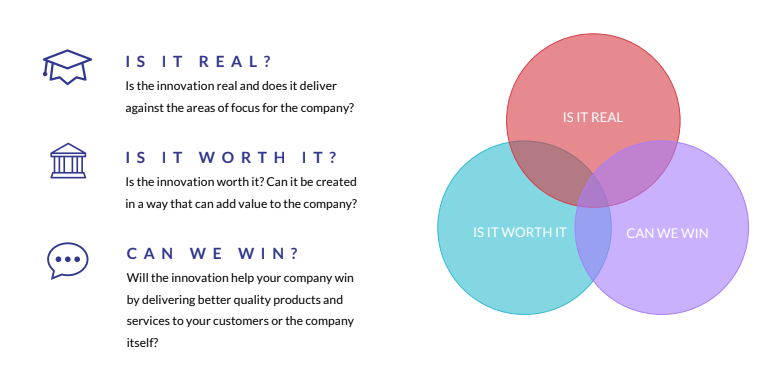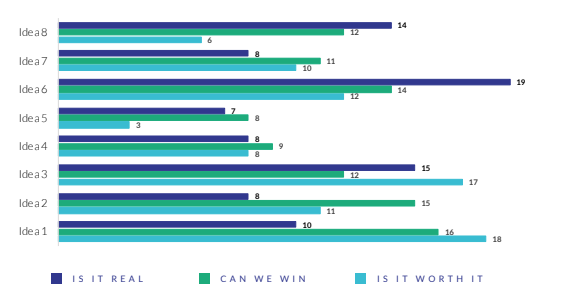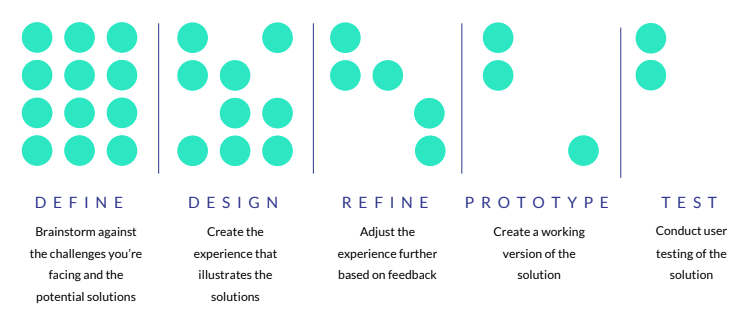Adopt tried-and-tested innovation management processes to free creative thinking and distill big ideas into the solutions that drive your business forward.
Blind obsession with a single perfect idea is the enemy of innovation. Creating a process that your teams can leverage to explore multiple solutions for your biggest challenges is where innovation thrives.
As I talked about in my recent publication, Old Problems. New Solutions: How to Use Iterative Innovation to Grow Your Business, too many companies are obsessed with finding the winning solution before they take any action. The result is analysis paralysis. Shift your thinking and be open to the notion that every problem can have multiple solutions. Innovation is messy and unpredictable – it’s not a straight line that gets you across the finish line. Throw everything at the wall and see what sticks. Like any worthwhile journey, there are many ways to get to where you want to go. This fundamental adaptation in the way teams are allowed to work and think is what unleashes the power of iterative innovation.
The journey of innovation invariably looks something like this. You begin by acknowledging one priority has multiple solutions.

Plan for the five phases of iterative development

The act of iteration naturally builds a repeatable, measurable development approach to creating innovative products. During each of these standardized phases, you’ll find multiple ideas that solve a single problem, particularly during the Define phase. My recommendation, which has worked for the companies I’ve consulted with to date, is to have several teams ideate independently to come up with dozens of potential solutions for the challenge.
Each of these phases lasts one to two weeks. As you proceed, you’ll start with a goldmine of ideas and wean them down to what makes the most sense. This process allows you to begin with low-fidelity ideas to high-fidelity prototypes testable with real users. A lot of these ideas will get half-way or all-the-way through and then fail. And that’s ok. Innovative companies fail a lot. And so will you.
Track raw potential with RWW
At the end of each iterative cycle, there’s always a single day to test and evaluate your ideas’ performance. That’s your RWW day.
RWW stands for “Is it real? Is it worth it? Can we win?” I created this framework a long time ago to measure innovation pursuits in real-time. This simple methodology develops the criteria that give your team measurements to track performance. Most importantly, it’s how you learn from your failures and plan how you’ll apply those learnings to augment your potential successes.

Be sure that the business mindset is also represented as you work through your answers. It’s not only a matter of whether your customer will want it but also if you can produce it as a company. They have to work in tandem, and one can’t be sacrificed for the other.
Use RWW to score your ideas
Go from multiple interesting solutions to the winning answer by scoring your ideas across the three RWW pillars. This will give you a quantifiable approach to strategically figure out which have the most potential.
Here’s an example:

This method gives you a framework so that all stakeholders can agree on the results. You’ll be able to clearly define the pros and cons of each potential idea throughout its development, giving you a solid idea of which ones are worth taking to the next round. That’s the whole point of iterative innovation; you rely on repeating cycles of development to refine your strongest ideas. At the same time, you keep them relevant by regularly measuring them back to these requirements for success. The scoring becomes more and more critical as you go along because it standardizes how you measure each idea’s potential value and helps you make unbiased decisions.
Once you have a sense of where your bar for approval lies, tally up the totals from the three RWW pillars into a single score for each idea. Add a numeric value to where you draw the “go/no-go” for project development, and you can instantly see which project should advance to the next cycle.
It will look something like this:

This approach works best when you start several ideas. Going back to the idea of casting a wide net during the define phase, if you start testing only a small number of ideas, you won’t reap the benefits of this process.
Below is a visual for a project that started with 12 ideas and ended with two viable tests.

Testing too early, before understanding impact and whether a concept is ready, is dangerous and might not provide you with significant value. Getting products in front of customers is essential but can lead you into an endless cycle of testing… just for the sake of testing.
Remember these three tips:
- Think big, don’t fear failure, treat every idea like a great idea, and trust the five phases of iterative development and RWW framework to guide you.
- Throw everything against the wall, and RWW will show you what sticks.
- Attempting to predict where your next innovative idea will come from is a surefire way to limit innovation.
Traveling down this path will lead you to one priority with one solution.
There is no perfect idea. The magic of iterative innovation is that you have a process to explore a multitude of potential solutions and measure them equally to find the best idea. And that, for lack of a better term, is as close to perfect as you’re going to get.
Change isn’t easy, but it is necessary. Act now – enable processes that empower your entire organization with the agility and readiness to innovate and drive growth. There’s so much more about this topic inside, Old Problems. New Solutions: How to Use Iterative Innovation to Grow Your Business.


